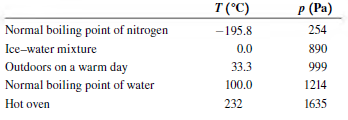A steel cylinder with rigid walls is evacuated to a high degree of vacuum; you then put
Question:

(a) Recall (Chapter 17) that absolute zero is the temperature at which the pressure of an ideal gas becomes zero. Use the data in the table to calculate the value of absolute zero in °C. Assume that the pressure of the gas is low enough for it to be treated as an ideal gas, and ignore the change in volume of the cylinder as its temperature is changed.
(b) Use the coefficient of volume expansion for steel in Table 17.2 to calculate the percentage change in the volume of the cylinder between the lowest and highest temperatures in the table. Is it accurate to ignore the volume change of the cylinder as the temperature changes? Justify your answer.
Table 17.2
![Coefficients of Volume Expansion Solids В (к- оr (С)-1] Liquids B [K-! or (C°)-'] 75 x 10-5 115 x 10-5 Aluminum 7.2](https://dsd5zvtm8ll6.cloudfront.net/si.question.images/images/question_images/1539/3/5/5/5275bc0b38780a3c1539381175303.jpg)
Step by Step Answer:

University Physics with Modern Physics
ISBN: 978-0133977981
14th edition
Authors: Hugh D. Young, Roger A. Freedman





